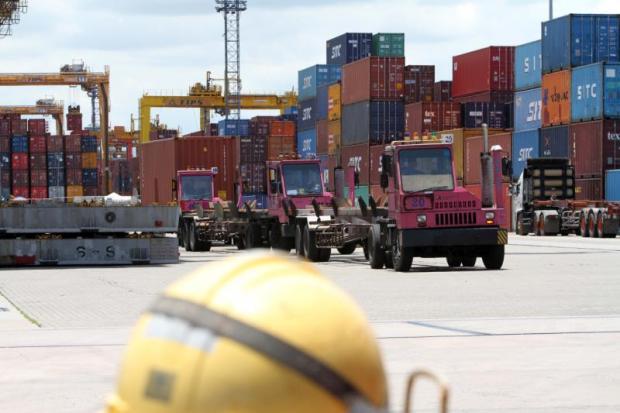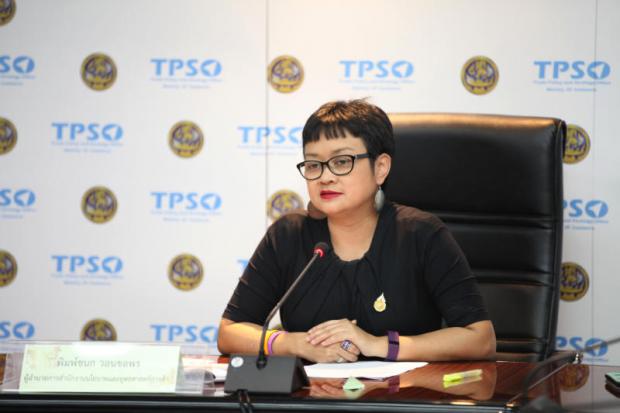
Thai exports will keep rising in 2018, fuelled by a 9.2% increase in global exports and the economic recovery of Thailand's major trade partners: the US, Japan, China and Europe.
Global exports will grow by 9.2%, according to the World Trade Organization. Moreover, prices for farm products and major commodities are expected to rise in line with global oil prices.
The Commerce Ministry's Trade Policy and Strategy Office (TPSO) forecasts 2018 export growth of 6.0-6.5% to US$250 billion (8.2 trillion baht).
TPSO director-general Pimchanok Vonkorpon said the forecast is based on the assumption of a weaker baht at 33-35 per dollar because of US trade policies, which may draw money back to the US and support the greenback; an average Dubai crude oil price of $50-$60 a barrel; and Thai GDP growth of 4%.

Sompop: Thailand is a major supply chain
Government policies to support new investment in S-curve industries should help increase the production capacity of major Thai industries and the agricultural sector, helping meet rising export demand, she said.
Increased production due to rising investment is expected to be seen among key export products such as automobiles and parts, electronics, computers and parts, and agricultural products.
But some external risks may weigh on Thai exports, including a volatile exchange rate and global political instability.
Thai exporters said their greatest concern is the stronger Thai baht, which could eat into Thailand's competitive advantage.
For 2017, the TPSO is still confident that annual exports for the whole year will grow by 10% to $235 billion baht.
That would be the highest rate in six years and well above export growth of 0.5% in 2016, when total export value was $215 billion.
The TPSO attributed the rise in 2017 exports to the global economic recovery.
To help Thai exports maintain their growth momentum, the Commerce Ministry will focus more on emerging markets, including China, India and South Africa. Moreover, the ministry will also work to increase the popularity of Thai products in major traditional markets such as the US, Japan and the EU.
The Commerce Ministry plans to improve new marketing channels via online platforms, increasing the availability of Thai products via well-known e-commerce platforms such as Lazada and Alibaba. This move is further intended to help promote Thai small and medium-sized enterprises (SMEs).
The brighter export forecast for 2017 matches that of the Thai National Shippers' Council (TNSC), which also predicts that Thai goods will see better-than-expected growth.

Ghanyapad: Competition is revving up globally
TNSC chairwoman Ghanyapad Tantipipatpong said Thai exports in 2017 grew substantially in several sectors, including frozen and processed seafood, rubber products, chemical products, automotive and parts, electrical components, and computers.
But she reiterated that the stronger baht could affect exports in 2018, urging the Bank of Thailand to take action to curb the currency's value to help maintain the competitiveness of Thai goods.
Since most Thai shippers are SMEs, the impact from falling exports would be larger than in the past, when most exporters were big enterprises.
"If SMEs suffer losses, 90% of workers in the economic system do not feel they are benefiting from growing exports," Ms Ghanyapad said. "That is because up to 90% of exporters are SMEs."
Moreover, she said Thai exporters have to be on alert as competition in the global market has intensified, with more export-oriented countries in Asean revving up their productivity and competitiveness to vie with Thailand.
Ms Ghanyapad said the TNSC is maintaining a conservative 2018 export growth projection of 5%, in part because of the high-base effect, among other factors.
She likewise said that US tax policy encouraging profit repatriation to the US, bolstering the greenback against the baht and other regional currencies, is a concern.
Those conditions could push the baht into more volatile territory in 2018, Ms Ghanyapad said.
Sompop Manarungsan, the president of the Panyapiwat Institute of Management, said robust export growth of 10% in 2017 was not a surprise, since Thailand is a major supply chain for major exporters such as China, Japan and South Korea, all of whom boast higher export growth rates.
That reality should make Thai exporters rethink whether they are reaping the real benefits from growth in 2017, he said.
For the 2018 export outlook, Mr Sompop said China is poised to upgrade the quality of its goods, implementing more environmentally minded measures, which could have an affect on Thai exports in 2018.
"That would make Thai exports grow at a slower rate next year compared with 2017," he said.

Pimchanok: S-curve sectors will boost capacity